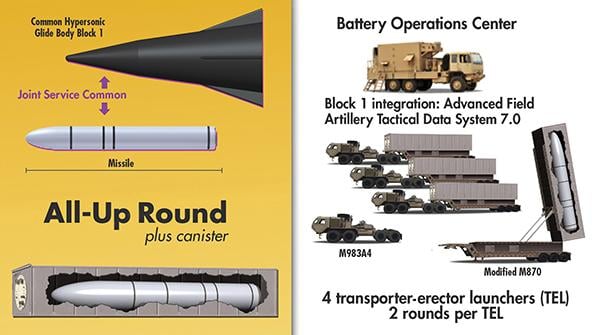
Two years before the first battery is fielded, the next stage of technology development for a joint U.S. Army/Navy hypersonic missile program is set to begin.
A series of technology insertions aims to make hardened, mobile and relocatable targets vulnerable to the second tranche of the Army’s land-based Long-Range Hypersonic Weapon (LRHW) batteries and the first tranche of the Navy’s submarine- and surface-launched Intermediate-Range Conventional Prompt Strike (IRCPS) missiles, both scheduled to arrive in fiscal 2025.
- Terminal seeker and data link planned
- New warheads have been proposed
The identical all-up round—a canister with a 34.5-in.-dia. two-stage booster and Common Hypersonic Glide Body (CHGB)—used by both programs is set to be fielded by the Army’s first LRHW battery in fiscal 2023, but it will feature a target set limited to fixed sites such as radar and communications dishes.
To move beyond those limitations, the cooperative Army/Navy program is developing a technology insertion plan that seeks to introduce an inflight retargeting capability and—most challenging of all—a terminal seeker.
“That’s not going to be an easy one,” said Robert Strider, deputy director of the Army Hypersonic Project Office, referring to a terminal seeker, at the Nuclear Triad Symposium on July 7.
The reentry speed of a CHGB launched by an LRHW/IRCPS missile may be as high as Mach 15. At those speeds, friction heating causes the airflow around the CHGB to ionize, creating a plasma sheath that interferes with incoming communications signals and outgoing transmissions by a radio-frequency sensor.
Solving the inflight retargeting problem with an inflight communications update appears feasible in the near term, said Strider. “We think we’ve got the pieces,” he said. “We’ve got to see how it all fits together.”
The harder problem is integrating a terminal seeker within the dimensions and environment of a biconic-shaped, hypersonic glider.
“Getting something that will be able to go after moving or relocated targets, you know, that’s a different story right now based on the maturity of some of the technologies,” Strider said. “We’ve got a lot of big brains that are looking into this.”
The Army and Navy also are interested in alternative warheads, said Capt. Gregory Zettler, the IRCPS program manager. The Air Force’s first hypersonic weapon—the Lockheed Martin AGM-183A—is equipped with a tungsten fragmentation warhead. If the LRHW/IRCPS is equipped with a similar warhead, the gliders would be limited to attacking soft targets. Alternative warheads could include penetrators for hardened targets or underground bunkers and cluster submunitions.
Although Zettler and Strider spoke at a symposium on nuclear weapons, Defense Department policy limits the new class of maneuvering hypersonic missiles to conventional explosives. But some defense officials expect that LRHW and IRCPS missiles could achieve a deterrent effect similar to a strategic nuclear weapon. In fact, in a recent exercise called the Joint Warfighting Assessment 2021, the presence of an LRHW battery was enough to deescalate a simulated conflict.
“They didn’t even shoot [the LRHW] because they didn’t have to,” Strider said. “When it shows up, it does what it’s supposed to do, which is deter any kind of conflict and let them know how serious we really are.”
Coming into service two years ahead of the IRCPS, the LRHW program is entering a critical period of flight testing. Earlier versions of the CHGB were tested three times between 2011 and 2017, with one failure in 2014. The first test of the operational version of the CHGB followed successfully in March 2019.
Strider said the Army is now preparing “very soon” for the next milestone test: Joint Flight Campaign (JFC)-1, which will be the first test of the CHGB and the two-stage missile stack. The Army slimmed the operational boosters to a diameter of 34.5 in. so the IRCPS will fit into the launch cells of the Navy’s Virginia Payload Module, he said.
A successful JFC-1 test will validate the performance of the all-up round from a launchpad. The next milestone will come in fiscal 2022 with the JFC-2 test, which will be the first from a transporter-erector launcher (TEL), Strider said. Lockheed has delivered all four TELs already to support the first battery. A follow-on JFC-3 test in fiscal 2022 will be the first to be directed by an operational unit, with no program office or contractor engineers providing supervision.
“When you think about normal programs of record—at the pace that they normally work and the milestones they go through—this is lightspeed,” Strider said.






Comments
The LRHW/IRCPS missile just gets explosive force on a target sooner than in the past. This, by itself, has never deterred armed conflict. There is no reason to believe that hypersonic weapons will alter this calculus.
“They didn’t even shoot [the LRHW] because they didn’t have to,” Strider said. “When it shows up, it does what it’s supposed to do, which is deter any kind of conflict and let them know how serious we really are.”
Let's see. "it shows up", eight fast missiles with warheads that each can hold one surface target at risk like an antenna array (but not an armored vehicle or a bunker). Compare and contrast the Chinese SSM holdings, several hundred that can engage hardened targets.
Yep, the enemy, regardless of their aims, are "deterred", a favorite word of the Arms Control and Disarmament Association, right up there with "bargaining chip", hint.
This was a cooked war game with per-determined results.
Or better yet, since the Army missiles will probably be transported by ship make them all sea water proof.